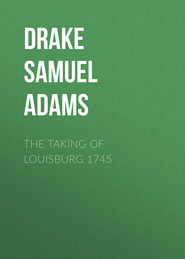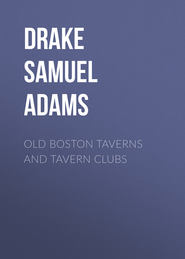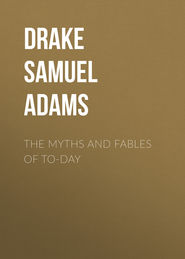По всем вопросам обращайтесь на: info@litportal.ru
(©) 2003-2024.
✖
Nooks and Corners of the New England Coast
Настройки чтения
Размер шрифта
Высота строк
Поля
274
By smashing their frigates, L'Insurgente, La Vengeance, Berceau, and making it generally unpleasant for them.
275
Duke de Feltre, French minister of war.
276
He afterward returned to France, and was made minister of war.
277
Fort Morgan was constructed by him with twelve posterns, a statement significant to military engineers. General Totten closed six of them, and the Confederates, when besieged, all but two.
278
Canonicut is about seven miles long, its longest axis lying almost north and south. It includes a single township, incorporated 1678, by the name of Jamestown. The island was purchased from the Indians in 1657. Prudence Island, six miles long, is also attached to Jamestown.
279
At this time four British frigates and several smaller craft were destroyed. The French forced the passage on the west of Canonicut, and raised the blockade of Providence.
280
The chasm is one hundred and sixty feet in length, with an average depth of about sixty feet.
281
Smibert planned the original Faneuil Hall, Boston. Trumbull painted in the studio left vacant bv Smibert.
282
British ambassador at St. Petersburg, afterward Lord Malmesbury.
283
Massachusetts Files.
284
Heath then commanded at Providence: he was ordered to meet Rochambeau on his arrival, and extend any assistance in his power.
285
The manner and matter of his reception of Mr. Adams were equally those of gentleman and king. Contrast him with the Prince Regent, and his remark to the French ex-minister, Calonne, during his father's sudden illness, in 1801: "Savez-vous, Monsieur de Calonne, que mon père est aussi fou que jamais?" (Do you know, Monsieur de Calonne, that my father is as crazy as ever?) Thackeray could not do him justice.
286
The fellow-prisoner of Count Christian Deux-Ponts was an Irishman, named Lynch, who belonged also to Rochambeau's army. Fearful that his nationality might be discovered, he begged the count to be on his guard. When at table, and heated with wine, the secret was divulged by the count; but Nelson, as Ségur relates, pretended not to have heard it.
287
That of Major Galvan, who pistoled himself on account of unrequited love.
288
Rally, Auvergne! here is the enemy!
289
William Ellery Channing, the pastor of "Old Federal Street," Boston, was one of the most gifted and eloquent men the American pulpit has produced. His mother was the old signer's daughter.
290
When appealed to by the United Colonies in 1657 to punish Quakers, Rhode Island objected that no law of that colony sanctioned it. The president, Benedict Arnold, however, replied that he (and the other magistrates) conceived the Quaker doctrines tended to "very absolute cutting down and overturning relations and civil government among men." He urged as a measure of public policy that the Quakers should not be molested, as they would not remain where the civil authority did not persecute them. This has, in fact, been the history of this sect in New England. – See Arnold's letter, Hutchinson, vol. i., appendix.
291
George Fox was in Rhode Island in 1672. On arriving at Newport, he went to the house of Nicholas Easton, who was then governor, and remained there during his sojourn. A yearly meeting of all the Friends in New England was held while he remained in Newport. – "George Fox his Journal," London, 1709.
292
Josselyn mentions the sect: "Narraganset Bay, within which bay is Rhode Island, a harbor for the Shunamitish Brethren, as the saints errant, the Quakers, who are rather to be esteemed vagabonds than religious persons." He also attributes to them dealings in witchcraft. Whittier, the Quaker poet, has depicted in stirring verse the persecutions of this people. Cassandra Southwick is from real life.
293
Stones giving simply the name and date of decease are now allowed.
294
In 1708 M. de Subercase solicited of his Government the means of attempting an enterprise against the island of Rhode Island. He says, "Cette isle est habitée par des Coakers qui sent tous gens riches."
295
Here also is the grave of Governor Henry Bull, who died in 1693, and whose ancient stone house is now standing in Spring, near Sherman Street.
296
Stuart was in Boston at the time of the battle of Lexington, and managed to escape a few days after Bunker Hill. His obituary in the Boston Daily Advertiser, a very noble tribute from one man of genius to another, was written by Allston.
297
It was the fortress of the British left wing. Two large and elegant country houses at its base, included within the lines, were occupied by the officers.
298
He was the son of John, the son of Godfrey Malbone.
By smashing their frigates, L'Insurgente, La Vengeance, Berceau, and making it generally unpleasant for them.
275
Duke de Feltre, French minister of war.
276
He afterward returned to France, and was made minister of war.
277
Fort Morgan was constructed by him with twelve posterns, a statement significant to military engineers. General Totten closed six of them, and the Confederates, when besieged, all but two.
278
Canonicut is about seven miles long, its longest axis lying almost north and south. It includes a single township, incorporated 1678, by the name of Jamestown. The island was purchased from the Indians in 1657. Prudence Island, six miles long, is also attached to Jamestown.
279
At this time four British frigates and several smaller craft were destroyed. The French forced the passage on the west of Canonicut, and raised the blockade of Providence.
280
The chasm is one hundred and sixty feet in length, with an average depth of about sixty feet.
281
Smibert planned the original Faneuil Hall, Boston. Trumbull painted in the studio left vacant bv Smibert.
282
British ambassador at St. Petersburg, afterward Lord Malmesbury.
283
Massachusetts Files.
284
Heath then commanded at Providence: he was ordered to meet Rochambeau on his arrival, and extend any assistance in his power.
285
The manner and matter of his reception of Mr. Adams were equally those of gentleman and king. Contrast him with the Prince Regent, and his remark to the French ex-minister, Calonne, during his father's sudden illness, in 1801: "Savez-vous, Monsieur de Calonne, que mon père est aussi fou que jamais?" (Do you know, Monsieur de Calonne, that my father is as crazy as ever?) Thackeray could not do him justice.
286
The fellow-prisoner of Count Christian Deux-Ponts was an Irishman, named Lynch, who belonged also to Rochambeau's army. Fearful that his nationality might be discovered, he begged the count to be on his guard. When at table, and heated with wine, the secret was divulged by the count; but Nelson, as Ségur relates, pretended not to have heard it.
287
That of Major Galvan, who pistoled himself on account of unrequited love.
288
Rally, Auvergne! here is the enemy!
289
William Ellery Channing, the pastor of "Old Federal Street," Boston, was one of the most gifted and eloquent men the American pulpit has produced. His mother was the old signer's daughter.
290
When appealed to by the United Colonies in 1657 to punish Quakers, Rhode Island objected that no law of that colony sanctioned it. The president, Benedict Arnold, however, replied that he (and the other magistrates) conceived the Quaker doctrines tended to "very absolute cutting down and overturning relations and civil government among men." He urged as a measure of public policy that the Quakers should not be molested, as they would not remain where the civil authority did not persecute them. This has, in fact, been the history of this sect in New England. – See Arnold's letter, Hutchinson, vol. i., appendix.
291
George Fox was in Rhode Island in 1672. On arriving at Newport, he went to the house of Nicholas Easton, who was then governor, and remained there during his sojourn. A yearly meeting of all the Friends in New England was held while he remained in Newport. – "George Fox his Journal," London, 1709.
292
Josselyn mentions the sect: "Narraganset Bay, within which bay is Rhode Island, a harbor for the Shunamitish Brethren, as the saints errant, the Quakers, who are rather to be esteemed vagabonds than religious persons." He also attributes to them dealings in witchcraft. Whittier, the Quaker poet, has depicted in stirring verse the persecutions of this people. Cassandra Southwick is from real life.
293
Stones giving simply the name and date of decease are now allowed.
294
In 1708 M. de Subercase solicited of his Government the means of attempting an enterprise against the island of Rhode Island. He says, "Cette isle est habitée par des Coakers qui sent tous gens riches."
295
Here also is the grave of Governor Henry Bull, who died in 1693, and whose ancient stone house is now standing in Spring, near Sherman Street.
296
Stuart was in Boston at the time of the battle of Lexington, and managed to escape a few days after Bunker Hill. His obituary in the Boston Daily Advertiser, a very noble tribute from one man of genius to another, was written by Allston.
297
It was the fortress of the British left wing. Two large and elegant country houses at its base, included within the lines, were occupied by the officers.
298
He was the son of John, the son of Godfrey Malbone.











